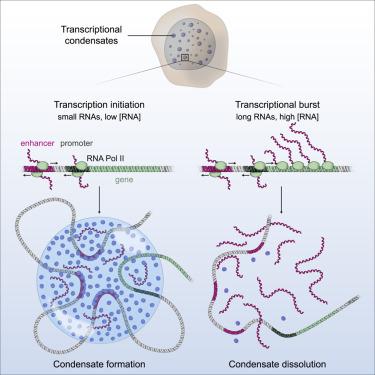Cell ( IF 45.5 ) Pub Date : 2020-12-16 , DOI: 10.1016/j.cell.2020.11.030 Jonathan E Henninger 1 , Ozgur Oksuz 1 , Krishna Shrinivas 2 , Ido Sagi 1 , Gary LeRoy 3 , Ming M Zheng 4 , J Owen Andrews 4 , Alicia V Zamudio 5 , Charalampos Lazaris 6 , Nancy M Hannett 1 , Tong Ihn Lee 1 , Phillip A Sharp 7 , Ibrahim I Cissé 4 , Arup K Chakraborty 8 , Richard A Young 5

|
Regulation of biological processes typically incorporates mechanisms that initiate and terminate the process and, where understood, these mechanisms often involve feedback control. Regulation of transcription is a fundamental cellular process where the mechanisms involved in initiation have been studied extensively, but those involved in arresting the process are poorly understood. Modeling of the potential roles of RNA in transcriptional control suggested a non-equilibrium feedback control mechanism where low levels of RNA promote condensates formed by electrostatic interactions whereas relatively high levels promote dissolution of these condensates. Evidence from in vitro and in vivo experiments support a model where RNAs produced during early steps in transcription initiation stimulate condensate formation, whereas the burst of RNAs produced during elongation stimulate condensate dissolution. We propose that transcriptional regulation incorporates a feedback mechanism whereby transcribed RNAs initially stimulate but then ultimately arrest the process.
中文翻译:

RNA 介导的转录凝聚物反馈控制
生物过程的调节通常包含启动和终止该过程的机制,并且如果理解的话,这些机制通常涉及反馈控制。转录调控是一个基本的细胞过程,其中涉及起始的机制已被广泛研究,但涉及阻止该过程的机制却知之甚少。 RNA 在转录控制中的潜在作用的建模表明,存在一种非平衡反馈控制机制,其中低水平的 RNA 促进静电相互作用形成凝聚物,而相对较高的水平则促进这些凝聚物的溶解。来自体外和体内实验的证据支持这样一种模型:转录起始早期步骤中产生的 RNA 刺激冷凝物形成,而延伸过程中产生的 RNA 爆发刺激冷凝物溶解。我们认为转录调控包含一种反馈机制,转录的 RNA 最初会刺激该过程,但最终会阻止该过程。











































 京公网安备 11010802027423号
京公网安备 11010802027423号